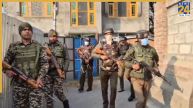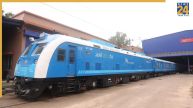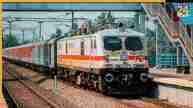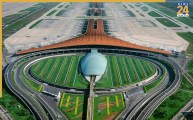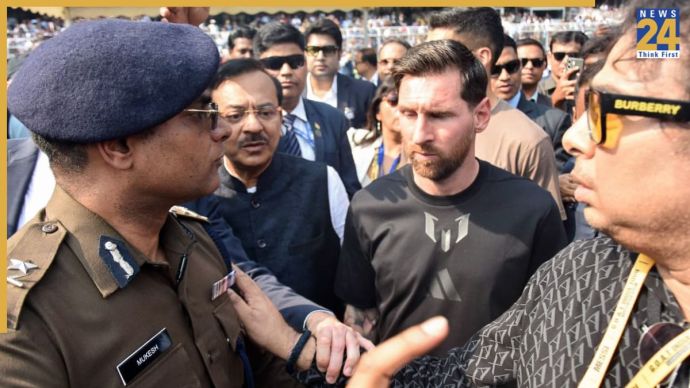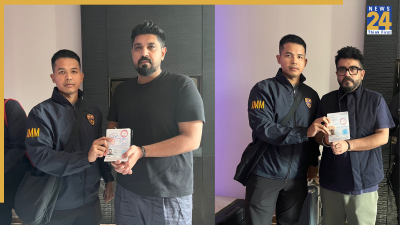The grand inauguration of the grand Ram Mandir is happening on January 22. The entire Ayodhya with the whole nation has immersed in joy and faith for lord Ram is returning once again to his territory. Ramdhun is the music of this year that’s reaching every heart and soul.
The reconstruction of Ram Mandir is a dream come true. A dream that took blood, sweat, and tears to manifest. One of the pillars that stood strong in this manifestation is Nripendra Misra, an IAS officer from Uttar Pradesh cadre who formerly served as the principal secretary to the PM of India and is now the chairman of the construction committee – Shri Ram Janmbhoomi Teerth Kshetra. Before the auspicious consecration, the Editor-in-chief of News24, Anurradha Prasad had an insightful conversation with him on different aspects of the Ram Mandir construction on her special show ‘Aamne Saamne‘.
Anurradha Prasad: To begin with, I’d like to ask whether the work you undertook resulted from meticulous planning on your part or was solely guided by Lord Ram’s will.
Nripendra Misra: I must emphasize that it was a result of both. Meticulous planning involved intricacies in design, technological engineering, and material management at a microscopic level. Engaging internationally renowned agencies like L&T and TATA made this project truly remarkable. The planning considered the aspirations of locals and people residing globally, envisioning the temple’s lifespan to exceed 1000 years, reminiscent of the historical practice where kings took centuries for similar projects.
Anurradha Prasad: That’s what I am getting at. Did the team, led by you, plan after the Supreme Court’s verdict came out, or did you plan ex-ante for this so that as soon as the verdict was out, you could get going?
Nripendra Misra: No planning was possible beforehand as no one could foresee this verdict. The architect’s agreement, signed in 1992, lacked crucial details. Even when I took control, I observed basic deficiencies and a plan for only a simple temple structure.
Anurradha Prasad: Who directed the construction of such a vast temple?
Nripendra Misra: Once given the authority to oversee the reconstruction, I brought on board agencies like IIT, eventually leading to the conception of the mega design.
Anurradha Prasad: How strenuous was the undertaking of this mega project?
Nripendra Misra: As you began by asking if this project was a result of detailed planning or sheer reliance on Lord Ram’s will, I will now address the second part. Whenever we sought support, it was due to the blessings of Lord Hanuman. Every individual and institution involved worked with complete dedication and a sense of spiritual fulfillment beyond mere duty.
Anurradha Prasad: You mentioned Lord Hanuman; do you also plan to construct his temple there?
Nripendra Misra: Yes, indeed. As Lord Ram’s das, Hanuman would have been involved. It is believed that every visit to the Ram Temple in Ayodhya should begin with paying tribute to Hanuman at Hanumangarhi. The Trust proposed a 3-stage plan, focusing on groundwork and sanctum sanctorum in the first phase, completing the temple top in the second, and constructing the entire complex in the third.
Anurradha Prasad: As a woman, I have to ask where Goddess Sita is visible amidst this construction process.
Nripendra Misra: I’m glad you asked. Goddess Sita is present in two forms – one as shakti (divine power). The portion referred to as Sita Rasoi (Kitchen) has been transformed into the Annapurna Temple. Additionally, on the first floor, where Ram Ji is portrayed as a prince, a Ram Durbar will be constructed, featuring his entire family – Lord Ram, Goddess Sita, his brother Lakshman, and Hanuman.
Anurradha Prasad: There must be challenges coming your way in completing the work in such a short duration.
Nripendra Misra: The foremost challenge was laying the foundation. The question was whether it should be soil-based or with the removal of soil. With no agreement in sight amongst the experts, we cleared 2.5 acres and dug 15 metres to fill it with engineered soil.
Anurradha Prasad: In connection with this, if the new temple will house a new Ram Lalla, what happens to the ancient idol?
Nripendra Misra: Both the new and old idols will be placed together – the former as an immovable idol and the latter for festive occasions.
Anurradha Prasad: You have had a long association with the Ram Temple, from being a bureaucrat under Mulayam Singh Yadav to this.
Nripendra Misra: Those times were different. As a bureaucrat, I had a different role. Late Shri Mulayam Singh Yadav Ji believed in maintaining law and order. Later, while working with Late Shri Kalyan Singh Ji also, I provided both of them with the advice that I deemed fit and appropriate. On the contrary, my role now requires executionary ability. However, I must clarify that even then I was personally of the opinion of constructing the temple.
Anurradha Prasad: How did you manage your personal opinion and responsibilities as a civil servant?
Nripendra Misra: As a civil servant, I learned not to let personal beliefs overpower my responsibilities.
Anurradha Prasad: How do you see your contribution to completing this project today in your career?
Nripendra Misra: It’s a divine feeling. When I first entered the office in 2014, I couldn’t foresee any such development. It was only in 2016, that the collective consciousness of the nation started realizing that this awaited dream could be fulfilled, eventually completed with the Supreme Court’s verdict.
Anurradha Prasad: How was the Prime Minister’s involvement in the project?
Nripendra Misra: The Prime Minister adhered to the spirit of the Supreme Court’s direction for an autonomous trust overseeing construction with no government financial support. He emphasized ‘Zero Negativity,’ insisting on a positive atmosphere during construction.
Anurradha Prasad: Negativity has arisen since the consecration date announcement. What do you think of that?
Nripendra Misra: As soon as Lord Ram takes his seat, negativity will cease to exist.
Anurradha Prasad: Working with Prime Minister Narendra Modi, how has it been?
Nripendra Misra: The good part is that he takes ownership and monitors challenges closely, ensuring timely intervention. His success relies on a modular approach. I must inform you without you asking about it that the parkota (surrounding wall of the temple), is about 1 mile in length and will cost more than the main temple. Further, during execution, we became ambitious, using elements like Makrana Marble instead of Granite.
Anurradha Prasad: Do you foresee Ayodhya becoming a commercial hub or a spiritual city?
Nripendra Misra: It will be unfortunate if it becomes a commercial hub. Ideally, it should resemble Varanasi, enduring over time. Economic development, however, as I see it coming, will be on an unprecedented scale, requiring infrastructure revamping.
Anurradha Prasad: Will mobile phones be permitted inside the temple?
Nripendra Misra: Currently, for security reasons, mobile phones won’t be allowed. There will be over 12,000 lockers, and a holding area for 2,000 people will prevent overcrowding.



